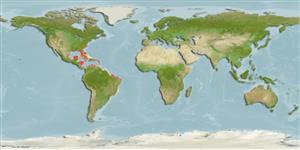Ircinia campana (Lamarck, 1816)
Vase garlic sponge| Native range | All suitable habitat | Point map | Year 2050 |

|
| This map was computer-generated and has not yet been reviewed. |
| Ircinia campana AquaMaps Data sources: GBIF OBIS |
Upload your photos
Google image |
No photo available for this species.No drawings available for Irciniidae.
Google image |
No photo available for this species.
Classification / Names Common names | Synonyms | CoL | ITIS | WoRMS
Demospongiae | Dictyoceratida | Irciniidae
Environment: milieu / climate zone / depth range / distribution range Ecology
Reef-associated; brackish; depth range 3 - 79 m (Ref. 108813). Tropical
Distribution Countries | FAO areas | Ecosystems | Occurrences | Introductions
Western Atlantic and Mediterranean Sea.
Length at first maturity / Size / Weight / Age
Maturity: Lm ? range ? - ? cm Max length : 0.5 cm H male/unsexed; (Ref. 415)
Short description Morphology
Vase shaped. Reddish brown externally, tan internally. Oscules: 0.1 - 0.5 cm wide, only on the inner side. Surface conulose: 0.1 - 0.5 cm high; 2 - 9 m apart. Compressible in consistency, tough to cut (Ref. 415). May also be cup- or bowl-shaped; cylindrical forms rather than widening upward possible. Cup sides may be of unequal heights. Conules on the inner surface of the cup distinctly lower and crowded. Weak to well-developed vertical ribs or ridges on outer surface possible, surface may appear almost smooth. Rubbery. Exudate absent (Ref. 85482).
Maximum depth reported taken from Ref. 128739. Rare on mangroves (Ref. 415), but common on shallow hard grounds, seagrass beds, and inshore reefs (Ref. 85482). Inhabits seagrass meadows, coralline algae reefs and lower mesophotic reefs (Ref. 128739).
Life cycle and mating behavior Maturity | Reproduction | Spawning | Eggs | Fecundity | Larvae
Members of the class Demospongiae are hermaphroditic. Life cycle: The zygote develops into parenchymella larva (free-swimming) before settling down on a substrate where it grows into a young sponge.
Main reference
References | Coordinator | Collaborators
Collin, R., M.C. Díaz, J. Norenburg, R.M. Rocha, J.A. Sánchez, M. Schulze, A. Schwartz and A. Valdés. 2005. (Ref. 415)
IUCN Red List Status (Ref. 130435)
CITES status (Ref. 108899)
Not Evaluated
CMS (Ref. 116361)
Not Evaluated
Threat to humans
Human uses
| FishSource |
Tools
More information
Internet sources
BHL | BOLD Systems | CISTI | DiscoverLife | FAO(Publication : search) | Fishipedia | GenBank (genome, nucleotide) | GloBI | Gomexsi | Google Books | Google Scholar | Google | PubMed | Tree of Life | Wikipedia (Go, Search) | Zoological Record
Estimates based on models
Preferred temperature
(Ref. 115969): 23.6 - 28.2, mean 27 (based on 525 cells).
Price category
(Ref. 80766):
Unknown.


